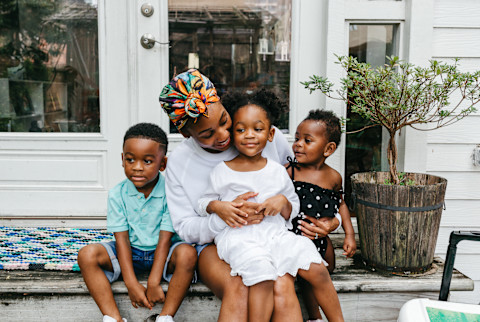How Being The Middle Child Can Affect Your Attachment Style

Middle children are often viewed as misunderstood or excluded. Like all birth order stereotypes, some will be accurate for one family, but not for another. Depending on how the parent-child relationship played out, a middle child who does experience this type of exclusion could take that subconscious hurt into their adult relationships.
The effects of being the middle child
"By definition, parents typically have less time, energy, and resources available to give middle children," licensed marriage and family therapist Tiana Leeds, M.A., LMFT, tells mbg.
If the oldest sibling was an only child for a period of time, they likely received more attention, and the youngest sibling will often be babied throughout childhood. "Compared to their siblings, children caught in the middle typically are not provided with the same level of consistent, focused parental attunement, a crucial element to fostering secure attachment," Leeds explains.
According to Leeds, this makes the middle child more likely than the other two siblings to develop an insecure attachment to their parents, which, without healing, might affect their romantic relationships later in life.
Possible attachment style outcomes
If a middle child really does experience less attention from their parents compared to their siblings, the two most common insecure attachment styles they might adopt are anxious attachment or avoidant attachment, Leeds says.
Parents with three or more children are often juggling the needs of each kid, while also dealing with other daily responsibilities. This can make it difficult to dole out care fairly, Leeds explains. Of course, the middle child is not always neglected or overlooked. "Some parents may be able to attune well to their middle kid but are not able to do so consistently because of the competing needs of their youngest and oldest," she says.
Not being able to predict whether a parent will be loving and present or emotionally unavailable can be confusing for a child and is usually a precursor to anxious attachment style. "This leaves a child not knowing what to expect and hungry for attention and connection," clinical psychologist Bobbi Wegner, Psy.D., writes in her upcoming book Raising Feminist Boys. This insecurity and lack of trust may cause them to become possessive, overly dependent, and clingy toward their partner.
On the other hand, if the parent is more consistently inattentive, the child would be more likely to develop avoidant attachment style, Leeds says. When people with avoidant attachment grow up, they often become extremely self-reliant and uncomfortable when relationships become too serious.
The bottom line
While these potential attachment style outcomes are related to more extreme scenarios of a middle child being ignored or at least less cared for than their siblings, it's not always accurate for everyone—and if it is, it's possible to heal from these attachment styles.
"While the heart can be fickle, the human brain is incredibly complex, constantly changing, and can build healthy new habits and ways of loving," marriage counselor Linda Carroll, M.S., writes for mbg. Here's her guide to healing old relationship patterns
